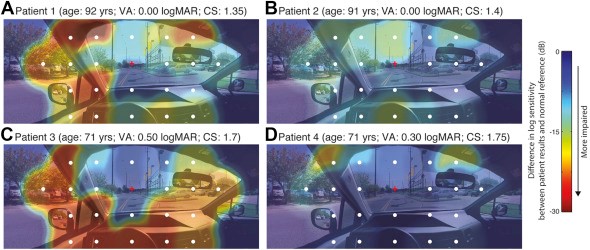A retrospective evaluation of police records revealed that older drivers with glaucoma had a 65% higher accident rate over 5 years compared with their peers without glaucoma.
Specifically, visual field (VF) defects in the superior, inferior and left divisions were associated most significantly with motor vehicle collisions.
Study design
Investigators used police records from the state of Alabama to determine the number of at-fault accidents among those aged 70 and older. From a sample of 2000 licensed drivers, 206 had various stages of glaucoma and the remainder were used as controls.
Outcomes
After adjustment for covariates such as age, vision and contrast sensitivity, drivers with glaucoma had a 65% higher accident rate (P=0.002). Visual field (VF) impairment emerged as an independent risk factor (P=0.027), with the rate of at-fault involvement almost 2.5 times higher among those with severe VF impairment compared with those with normal to moderate VF loss. No association was found among those with impaired visual acuity and contrast sensitivity.
When the visual field was subdivided into 6 regions (upper, lower, left, and right visual fields; horizontal and vertical meridians), an impaired left hemifield showed the highest risk ratio (RR 3.16; P=0.001), followed by upper (RR 2.37; P=0.014) and lower fields (RR 2.32; P=0.021). Deficits in the right side or along the horizontal or vertical meridian did not affect collision rates.

Normalized driving visual field sensitivity for 4 individual drivers with glaucoma. Each driving visual field map was superimposed on a driver's view of the windshield, side windows of the vehicle and the dashboard. White dots represent the target locations for the driving visual field test and the red crosshair indicates the driver's presumed gaze while driving. Warm colors indicate more visual field defects compared with reference normative data. A, C: Visual field maps of 2 drivers with severe visual field impairment who had a history of at-fault motor vehicle collision involvement. B, D: Visual field maps of drivers who were not involved in any at-fault MVC.
Clinical significance
These findings are important they provides direct evidence to use in conversations with patients and caregivers during counseling about driving safety. Clinicians can use this information to categorize and stratify patients with certain field defects as more or less likely to be at higher risk.
The study also underscores the importance of early detection and awareness of VF defects in enhancing older driver safety.
Limitations
This study is enlightening because of its clinical relevance, but it is important to note that these results refer to at-fault collisions from police records, and not patient reports.